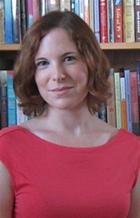 "It's thrilling and intimidating," says Kaylan Adair about working with Patrick Ness. As his American editor, she's worked with Ness since The Knife of Never Letting Go, the first in his Chaos Walking trilogy. She and Denise Johnstone-Burt, his British editor at Walker Books, work closely with Ness on his books. Adair describes him as "a genius," yet he's also open to suggestion and discussion. "Down to the last detail, he's thought things through so carefully," Adair says. "You get such insight into how his mind works."
"It's thrilling and intimidating," says Kaylan Adair about working with Patrick Ness. As his American editor, she's worked with Ness since The Knife of Never Letting Go, the first in his Chaos Walking trilogy. She and Denise Johnstone-Burt, his British editor at Walker Books, work closely with Ness on his books. Adair describes him as "a genius," yet he's also open to suggestion and discussion. "Down to the last detail, he's thought things through so carefully," Adair says. "You get such insight into how his mind works."
Ness does a first draft that no one sees, according to Adair. His first "public draft" goes to Johnstone-Burt, and then to Adair. With A Monster Calls, Adair says that the two editors conferred about what they thought needed finessing, to make sure they were "on the same page." Each gives her comments to Ness directly, and Adair includes Johnstone-Burt in her correspondence with Ness. When it comes to his work, Adair stressed the same theme that Ness talks about in reference to his writing: honesty. "It's brave and important to confront these conflicting and scary emotions, especially for this age range," Adair says of Conor's struggle to accept his mother's illness. "Patrick doesn't think kids ought to be protected from it. For Chaos Walking, too, there are such nuanced characters there. Everyone has such shades of gray, and that's what makes them thrilling and believable."
In the three stories the monster tells Conor, too, there is no black or white. "Conor is so past the easy answers," Adair points out. "He needs someone to tell it to him like it is. There's a guilt he's dealing with about the way he's reacting. It's appropriate but it's not what we're told is appropriate. There's no tidy way to grieve."
 Jim Kay's artwork for A Monster Calls also unfolds in shades of gray. "Anyone that watches horror movies knows that it's what you don't see that frightens you the most," says Kay, so he avoided showing too much of the monster in any one scene. That also allowed him to toggle between the creature's monster characteristics and his more human qualities. Kay felt that his early drawings depicted the monster as "too spindly, too manic. But from those came the idea to give him a scalp like a pollarded tree, and hands resembling a tangle of unearthed roots, complete with clumps of soil."
Jim Kay's artwork for A Monster Calls also unfolds in shades of gray. "Anyone that watches horror movies knows that it's what you don't see that frightens you the most," says Kay, so he avoided showing too much of the monster in any one scene. That also allowed him to toggle between the creature's monster characteristics and his more human qualities. Kay felt that his early drawings depicted the monster as "too spindly, too manic. But from those came the idea to give him a scalp like a pollarded tree, and hands resembling a tangle of unearthed roots, complete with clumps of soil."
We never see Conor in Kay's artwork. "It was a conscious decision that the character of Conor should remain personal to the reader," Kay explains. When he does show the boy, he appears in a ghosted outline. "It was more about getting across a feeling of his awkwardness, whilst describing him with as few marks as possible." Kay says it sometimes took more than 50 attempts to get the right image. "These 'loose' drawings are the hardest," says Kay. "It takes a lot of work to make something look effortless."
Kay only had two days to complete that first image that Ness said he admired so much (the monster's initial appearance at Conor's window). He wanted the whole image to be a collagraph print, but there wasn't enough time, so he went with a mixture of printmaking and markmaking. "With hindsight I'm glad we were pressured for time," Kay said. "It led to taking a lot more risks. Every image became something of an experiment, which I think gives the illustrations dynamism."

